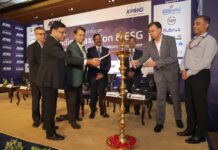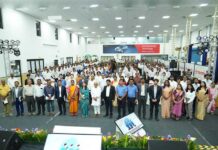
India’s battery manufacturing capacity, currently at nearly 60 GWh, is projected to reach 100 GWh by next year, according to Mr. Nikhil Arora, Director of Encore Systems.
Speaking at the 18th Renewable Energy India Expo, Arora highlighted India’s progress in large-scale localization of the energy storage value chain. “With automation efficiencies exceeding 95% and advanced six-axis robotics managing 625Ah, 12kg cells, we are driving high-precision manufacturing of next-generation batteries,” he said.
He added that sodium-based cell technologies, which are safer, highly recyclable, and ideal for grid-scale storage, are a testament to India’s growing self-reliance in clean energy.
“Collaborations with IIT Roorkee, NIT Hamirpur, and local automation partners are accelerating innovation and technology transfer. As storage costs decline from ₹1.77 to ₹1.2 per unit over the next five years, India is poised to achieve cost parity between solar energy and storage, strengthening its path toward energy independence,” Arora noted.
The 18th Renewable Energy India (REI) Expo and the 3rd The Battery Show India (TBSI), organized by Informa Markets in India, served as a crucial platform to strengthen global collaboration, innovation and investment in the clean energy ecosystem. These prestigious shows on innovative renewable energy and battery solutions brought together manufacturers, innovators, investors and policymakers.
Speaking at the event, Mr. Ankit Dalmia, Partner, Boston Consulting Group, said “India’s next five years will be shaped by advances in battery storage, digitalization, and green hydrogen. New emerging chemistries such as LFP, sodium-ion and solid-state batteries could cut storage costs by up to 40% by 2030, enabling 24×7 renewable power. AI-driven grid management and smart manufacturing are improving reliability and reducing system costs by nearly 20%. The National Green Hydrogen Mission, targeting 5 million tonnes of production annually by 2030, is positioning India to capture about 10% of global green-hydrogen capacity.”
“With the right policy support, manufacturing scale-up and global partnerships, India can become a resilient, low-cost hub for clean energy and battery innovation. India’s clean-energy ecosystem represents a US$200–250 billion investment opportunity this decade, with targets of 500 GW of renewables and 200 GWh of storage by 2030. Investors are focusing on hybrid RE + storage, grid-scale batteries, and pumped storage projects, while companies leverage AI and digital twins for smarter grid integration. Despite policy and land challenges, strong momentum and falling costs are powering rapid growth.” he further added.
Acharya Balkrishna, Head, Patanjali, said “At Patanjali, our vision has always been to contribute to the nation’s development and people’s prosperity through Swadeshi solutions be it in health, wellness, or daily essentials. Extending the same philosophy to renewable energy, we are committed to advancing solar and battery technologies that reduce foreign dependence and make clean energy affordable for all. Solar energy, a divine and continuous source, holds the key to meeting India’s growing power needs at minimal cost. Through Swadeshi-driven innovation and collaboration, we aim to ensure that sustainable and economical solar solutions reach every household in the country.”
Mr. Inderjit Singh, Founder & Managing Director, INDYGREEN Technologies, said “We provide customized battery solutions across L5, C&I, and utility-scale BESS segments, designed to balance performance, scale, and economics for Indian customers. With over 100 battery assembly lines successfully implemented, we aim to expand multifold in the next two years, targeting over 20 GWh of battery lines and 20 GW of solar PV manufacturing solutions. Leveraging IoT and AI-driven technologies, we enhance battery safety, thermal management, and lifecycle efficiency while supporting OEMs and Tier 1 suppliers with advanced insulation and fire-safety systems. Additionally, we’re enabling India’s industrial lithium cell ecosystem through pilot-line infrastructure for premier institutes and labs, alongside showcasing high-efficiency solar cell lines and large-scale BESS assembly solutions at REI and The Battery Show India.”
Sharing perspective on the co-located expos, Mr. Yogesh Mudras, Managing Director, Informa Markets in India, said, “India’s clean energy transition is accelerating faster than ever, with renewable capacity surpassing 250 GW in 2025 and a strong pipeline targeting 500 GW by 2030. The Ministry of Power has approved a ₹5,400 crore Viability Gap Funding (VGF) scheme for 30 GWh of Battery Energy Storage Systems (BESS), in addition to 13.2 GWh already underway, which is expected to attract ₹33,000 crore in investments by 2028.









